eCommerce: Social Commerce
Best Social Commerce Platforms: Facebook, Instagram, YouTube & More
Social media is no longer just a place to find old friends and watch cat videos. But what are the best social media platforms to shop on and how do they differ?
Article by Cihan Uzunoglu | March 19, 2024Download
Coming soon
Share

Best Social Commerce Platforms: Key Insights
Global Platform Usage: Facebook, Instagram, YouTube, TikTok, Pinterest, and Snapchat vary in social commerce popularity across different countries, as per data from Klarna.
Diverse Audience Engagement: Each platform, from video-focused YouTube and TikTok to visually driven Pinterest, engages distinct audience segments with tailored features.
Innovative Shopping Features: Platforms are introducing features like AR on Snapchat and direct shopping on Facebook and Instagram, enhancing online shopping experiences and separating themselves from the competition.
The days when social media was just a platform for sharing life updates and connecting with friends are long gone. Today, these platforms are bustling marketplaces where products are just a click away. Imagine finding that perfect pair of sneakers through a YouTube review or stumbling upon a must-have kitchen gadget while scrolling through Instagram. These are not isolated incidents but daily occurrences for millions of users worldwide.
But how exactly are these platforms weaving commerce into their social fabric? Does flipping through Facebook really lead to discovering not just what friends are up to but also products you didn't know you needed? And what about the newer players like TikTok — how are they carving out their own space in this crowded market?
Top Social Commerce Platforms
According to a recent survey by Klarna and Nepa, which gathered responses from 18 countries in Q2 23, Facebook leads the pack with more than half (52%) of respondents using it to buy products online. This doesn't come as a surprise, given Facebook's wide user base – 3.06 billion monthly active users as of Q4’23 – and its efforts to integrate shopping features into its platform. Instagram, another product of Meta Platforms, follows closely behind at 44%.
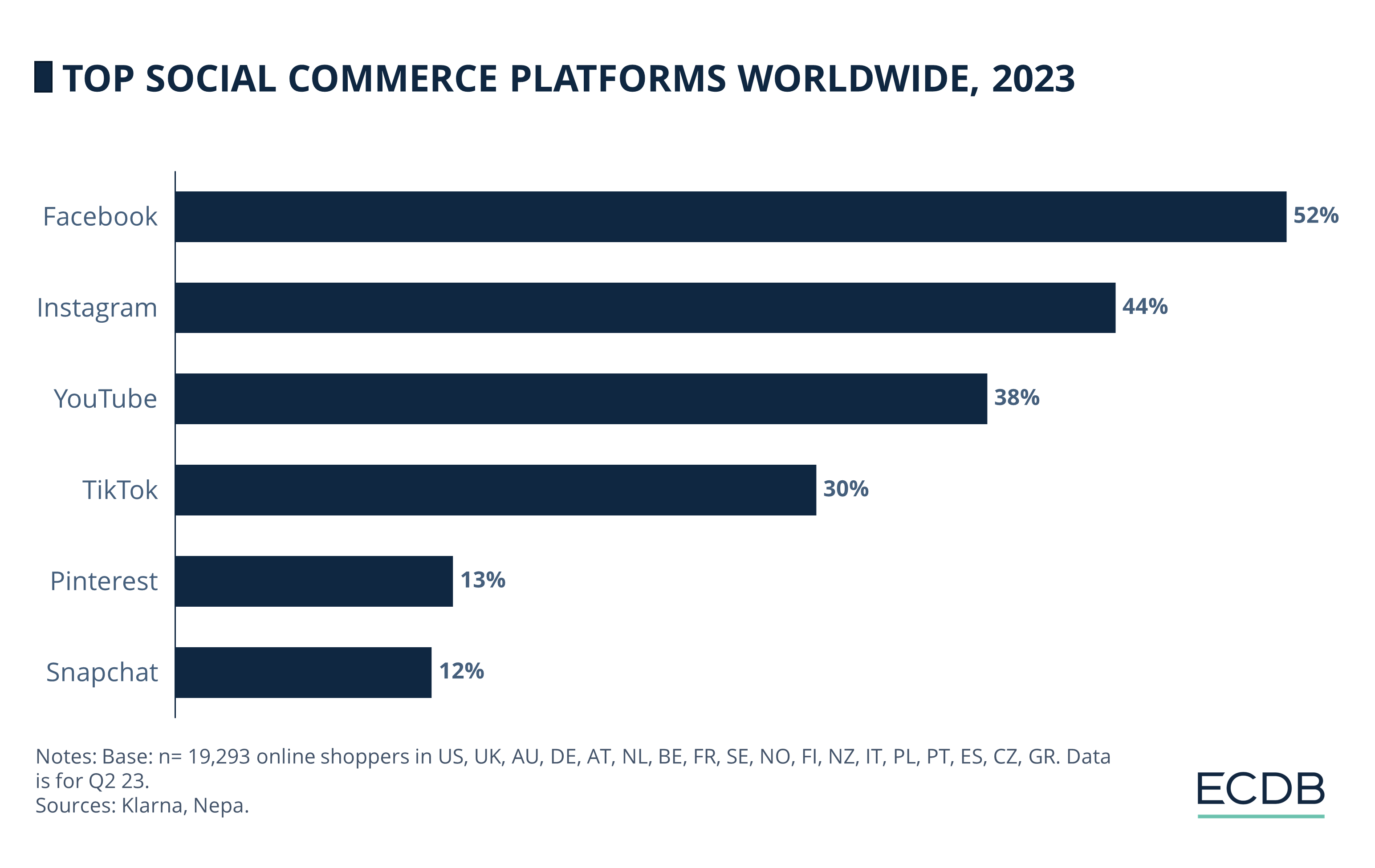
YouTube also plays a significant role in social commerce, with 38% of survey participants making purchases through it. The growing influence of video content in the shopping journey, where demonstrations and reviews can directly lead to sales, also puts another player in the forefront. TikTok, despite being a newer player, has quickly caught up, with 30% of respondents using it for purchases. Its unique algorithm and engaging content format make it a powerful platform for brands to reach potential customers.
Pinterest and Snapchat, while having smaller percentages at 13% and 12% respectively, still contribute to the social commerce landscape. Pinterest, known for its inspiration-driven content, and Snapchat, with its young demographic, offer niche opportunities for brands to connect with specific audiences.
To understand the value these platforms bring, however, we need to get into the specifics.
1) Facebook
With over 3 billion active users, Facebook provides an excellent chance for businesses to increase visibility through Facebook Shops. Launched in May 2020, this feature allows setting up online stores on Facebook and Instagram, enabling customers to shop directly from social media profiles.
The setup process is straightforward, requiring a Facebook Page and a Commerce Manager account. It offers a seamless shopping experience, where customers can browse, add to cart, and purchase without leaving the platform. Facebook Shops also allow product tagging and provide valuable insights to optimize offerings.
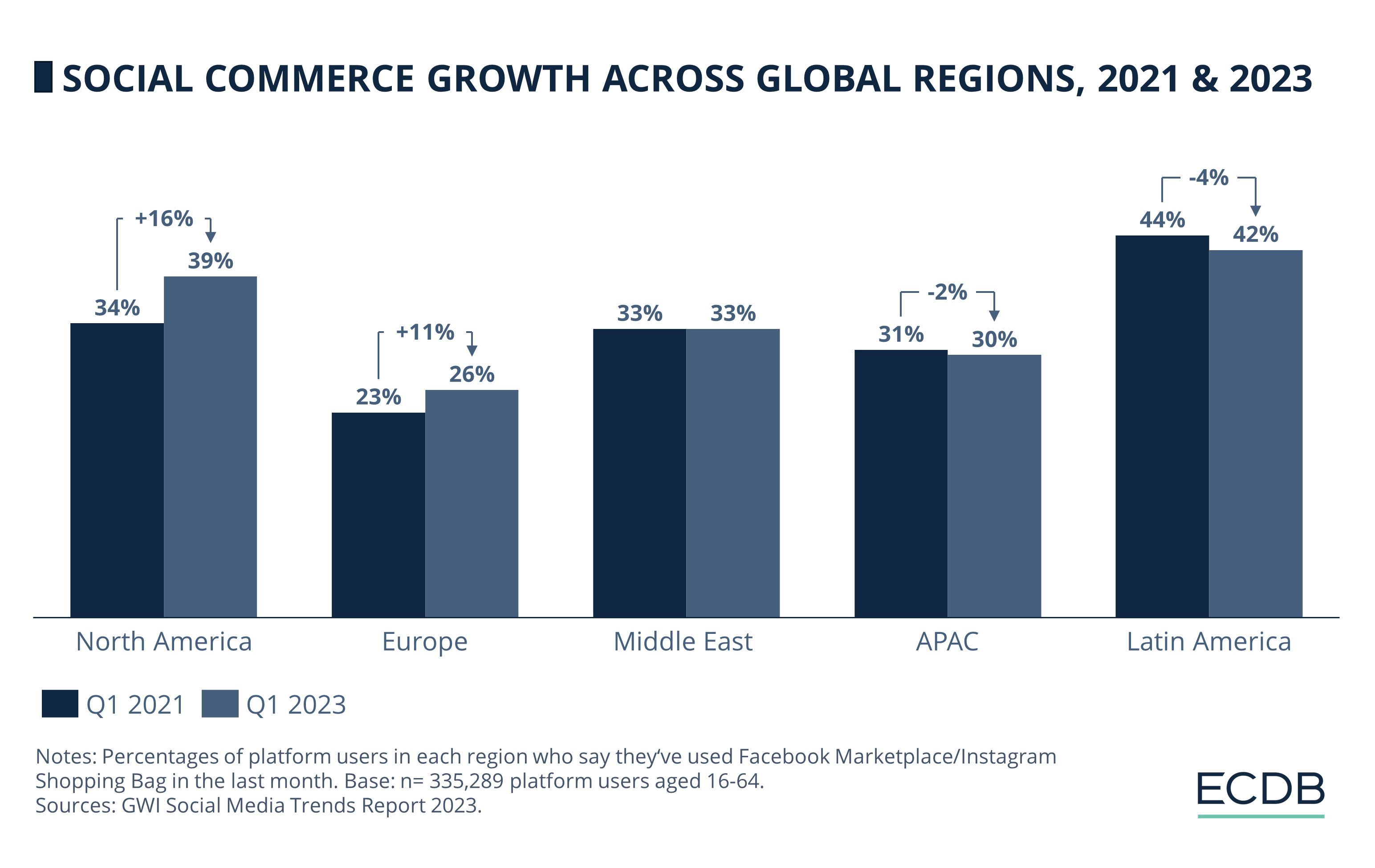
Latin America leads with 42% of users on Facebook Marketplace and Instagram Shopping Bag, followed by Asia Pacific at 30%, and Europe at 26%, though Europe's interest is growing, with an 11% increase since 2021.
Looking at Klarna's data in more detail, we see that the U.S., Australia and the Czech Republic are above the 60% mark when it comes to using Facebook to buy products. On the other hand, Austria and Spain are below 40%, indicating that the platform is less popular for social commerce in these countries.
Businesses also face challenges in using Facebook for social commerce, such as stringent eligibility requirements, limitations on product information, and the inability to capture direct consumer data, which hinders personalization and retargeting efforts.
2) Instagram
From just a photo-sharing app, Instagram has transformed into a major force in social commerce, having introduced shopping features and ad opportunities in the last few years. Features like Instagram Shop and Checkout on Instagram were designed for easy shopping directly in the app. Shop Ads and Reels Ads let users discover products and gave brands a way to connect creatively, driving sales.
A large number of Instagram users actively follow businesses, showing they're open to brand interactions on the platform. In terms of usage in different countries, Klarna data reveals that the platform is used for purchases most widely in Spain and Portugal, both at 57%, whereas social commerce engagement of the platform is rather low in the UK (35%) and Czechia (32%).

However, Instagram's journey in social commerce has faced challenges. In 2023, Meta removed the Instagram Shop tab, indicating a shift towards prioritizing advertising and engaging content over direct shopping features. This adjustment has led businesses to a crossroads: adopt Instagram's checkout and forfeit directing traffic to their websites, or lose the ability to tag products.
Despite the platform's extensive reach, many companies report poor conversion rates. The tendency towards impulse buying – in addition to overall low trust in social commerce – can tarnish brand reputation and customer satisfaction, failing to cater to the broader audience not immediately ready to purchase.
3) YouTube
Since its founding in 2005, YouTube has become a powerhouse in the realm of digital content, holding the title of the world's second-largest search engine. It's not only a favorite platform for watching videos but has also emerged as a significant channel for social commerce. The platform continues to be one of the pioneers of digital creator economy, taking on initiatives such as sharing ad revenues with creators through the YouTube Partner Program.
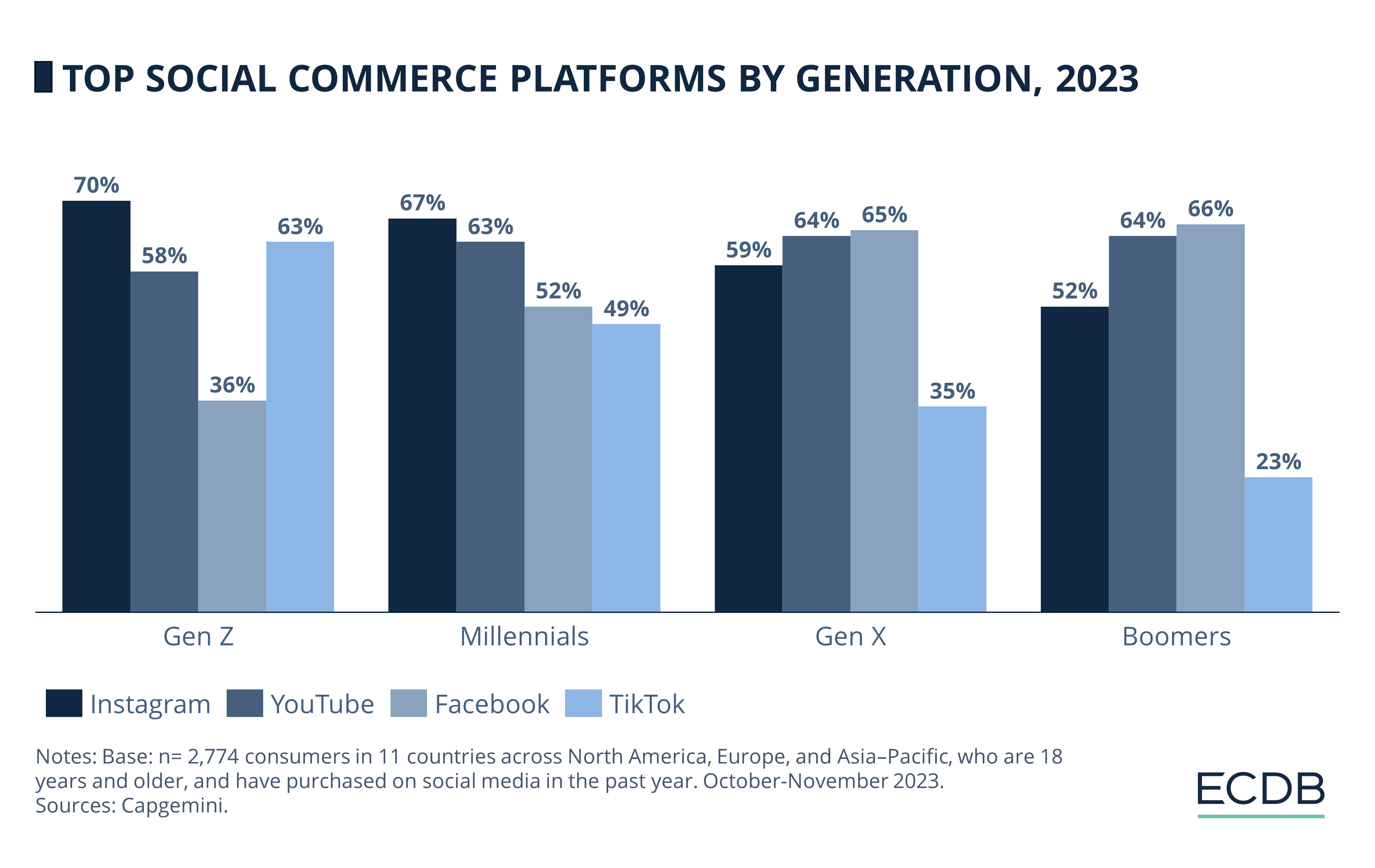
YouTube is a key player in social commerce, especially among Millennials and Gen X, with 63% and 64% usage respectively. It also matches Facebook's popularity among Boomers at 64%, although Gen Z's engagement was slightly lower at 58%.
Recognizing the potential of YouTube in the eCommerce space, the platform has rolled out features aimed at enhancing the shopping experience. These include a collaboration with Shopify that allows merchants to showcase their products in videos, the introduction of a timestamps feature for pinpointing shopping opportunities within content, and tools for bulk tagging of affiliate products across video libraries.
Such innovations provide creators and viewers alike with a more integrated and interactive shopping experience, aiming to boost creators' shopping revenue. But the social commerce penetration of YouTube varies in different countries. Diving into Klarna's data, we see that Germany (56%), the U.S. (55%), and France (52%) stand out with more than half of the surveyed individuals using YouTube to make purchases. Conversely, Portugal (29%) and Austria (27%) show considerably lower engagement, indicating a more tentative approach to adopting YouTube as a commerce channel in these areas.
4) TikTok
TikTok has swiftly become a major player in the social commerce arena, leveraging its vast user base (nearly 2 billion users worldwide) and content-driven platform to offer a unique shopping experience. TikTok Shop has established itself as a dynamic marketplace for over a billion users, blending entertainment with shopping seamlessly.
The platform has innovated to support brands in driving sales, with a suite of commerce products that simplify and optimize the shopping journey from discovery to purchase. This includes enabling brands to showcase and sell their products directly through in-app experiences, making it easier for users to buy without leaving the platform.
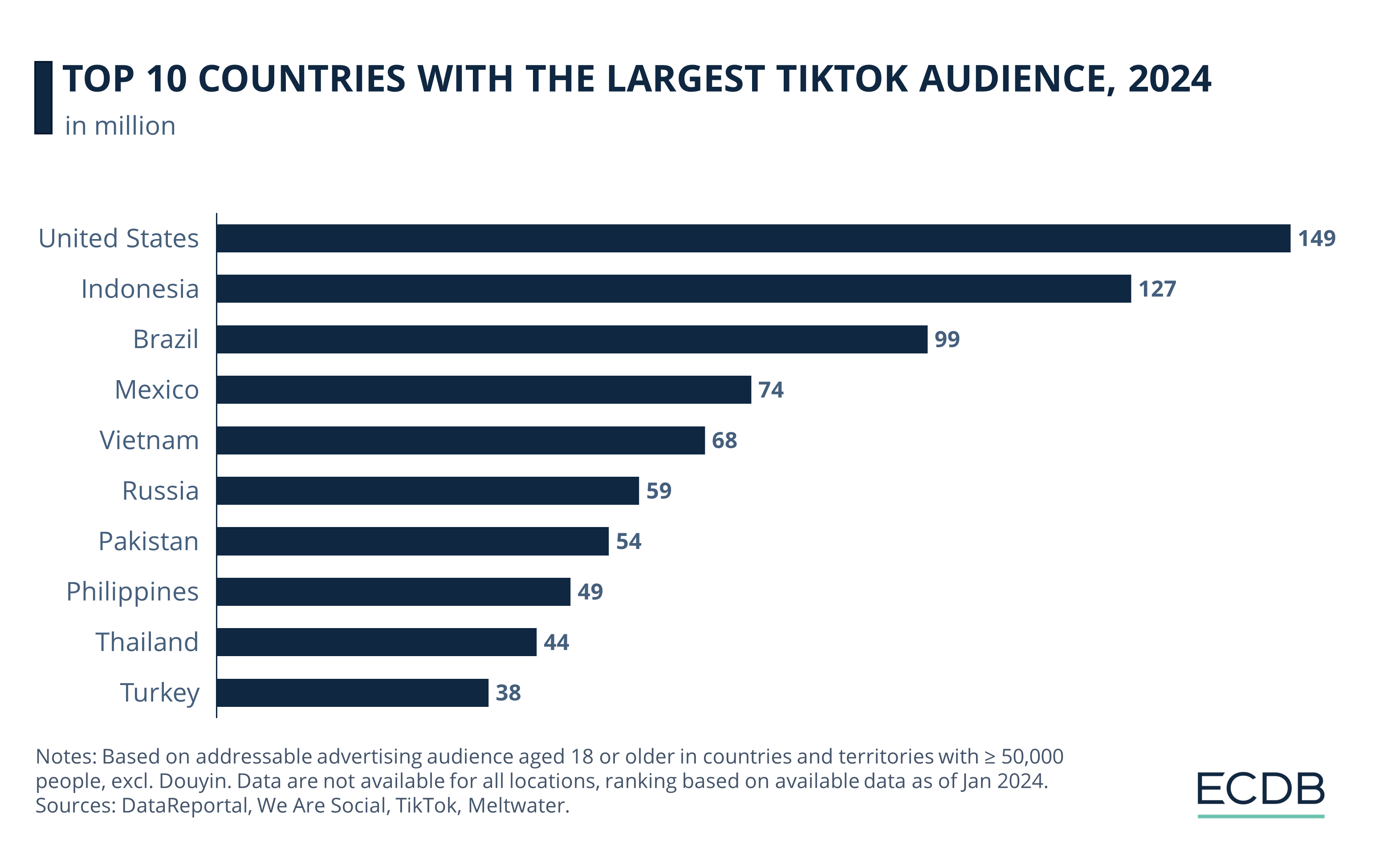
For brands and creators aiming to tap into TikTok's social commerce potential, strategic use of the platform's features is key. Call to Action (CTA) buttons, product links in videos, and TikTok LIVE sessions are effective tools for converting viewers into buyers. TikTok ads further extend reach, with the potential to engage nearly one fifth (18%) of internet users over the age of 18. For those on a budget, TikTok’s Promote feature can amplify organic posts for as little as US$3 a day.
Based on Klarna's findings, the platform is popular for social commerce in Australia, New Zealand, and Germany, each at 42%, followed by the U.S. at 40%. Conversely, the scenario shifts dramatically with Greece at 20%, Portugal at 16%, and Czechia at the lowest at 14%.
Successful brands on TikTok, such as Fenty Beauty, Dunkin’, Chipotle, Duolingo, and GoPro, have demonstrated the impact of aligning content strategy with audience interests and leveraging trending audio, CTAs, and engaging formats to drive engagement and sales. These brands have effectively utilized user-generated content such as tutorials, influencer partnerships, and behind-the-scenes content to connect with their audience and boost their presence on TikTok Shop.
5) Pinterest
Pinterest has solidified its role as a standout platform in the social commerce space. It's particularly praised for its frictionless, soft-sell approach to eCommerce, allowing users to explore and discover products in a non-intrusive manner. This unique strategy has led to significant user engagement in the U.S., standing out with a 23% shopping usage rate, contrasting with lower engagement in Sweden, Czechia, and Finland.
The platform's shopping features have been designed to enhance this seamless shopping experience. Notable features include "Shop in Search," where product pins automatically pop up in related searches, and "Shop with Lens," allowing users to snap a photo of an item and find similar products on Pinterest. These innovations are part of why Pinterest has become a leader in visual discovery and shopping.
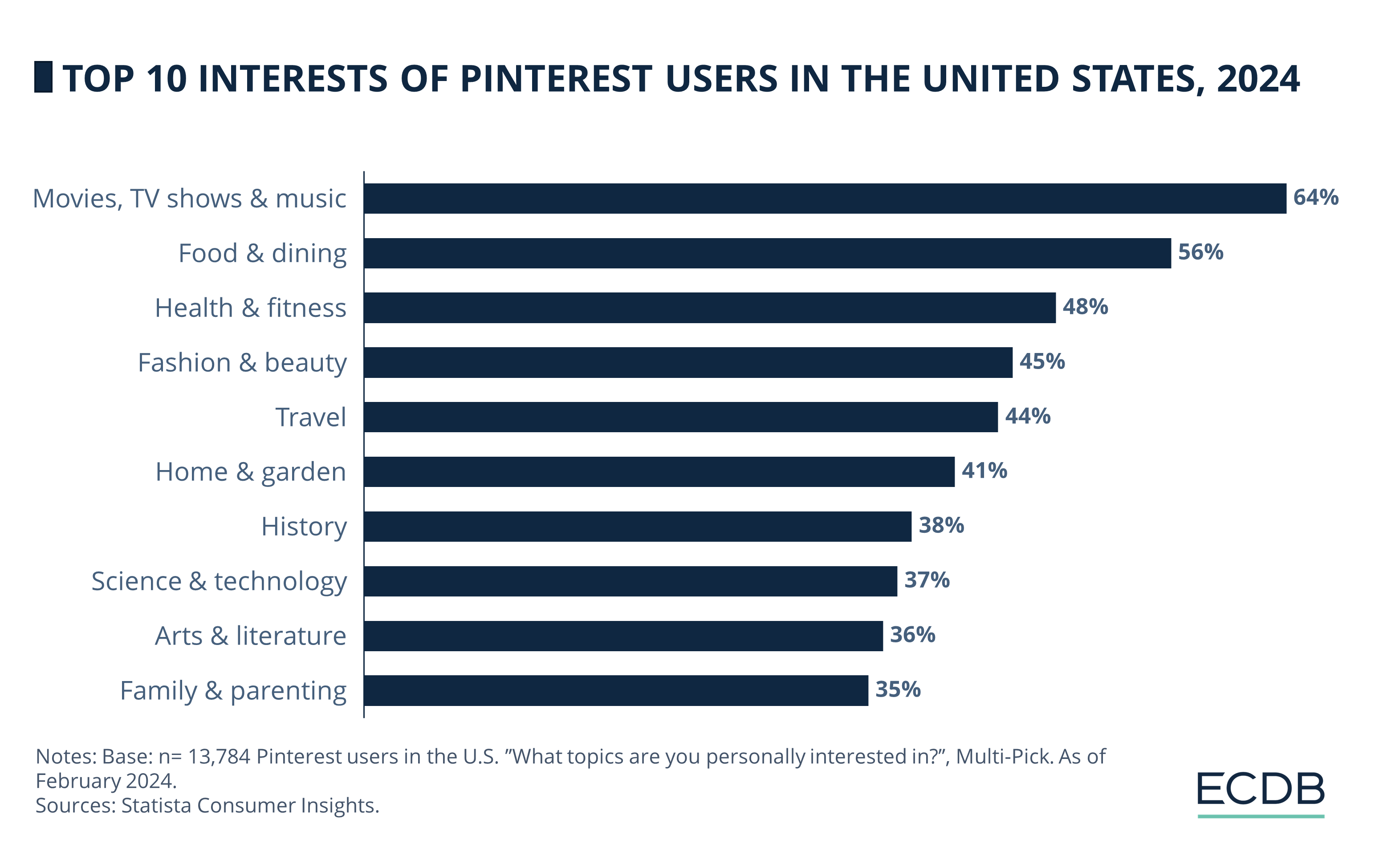
For brands and marketers aiming to leverage Pinterest for social commerce, joining the Verified Merchant Program is a critical first step. This program allows businesses to create product pins, get a shop tab on their profile, and access advanced conversion tracking analytics. Additionally, Pinterest's partnership with Shopify and other eCommerce platforms makes adding products as pins a straightforward process, further simplifying the transition into social commerce for businesses.
Moreover, Pinterest's focus on a positive, personalized, and inspirational user environment has contributed to its success in the social commerce domain. The platform's ability to stay drama and controversy-free, coupled with its targeted approach to monetization, has made it a preferred choice for both users and advertisers looking for a brand-safe environment.
6) Snapchat
Snapchat has emerged as a vital platform in the realm of social commerce, particularly appealing to a younger demographic with its innovative shopping features. Klarna's insights reveal its significant popularity in the U.S. at 29%, trailed by Norway at 23%, and closely followed by Australia and Germany both at 21%. Conversely, Italy, Czechia, Portugal, and Greece show minimal engagement, suggesting a varied global reception to Snapchat's commerce capabilities.
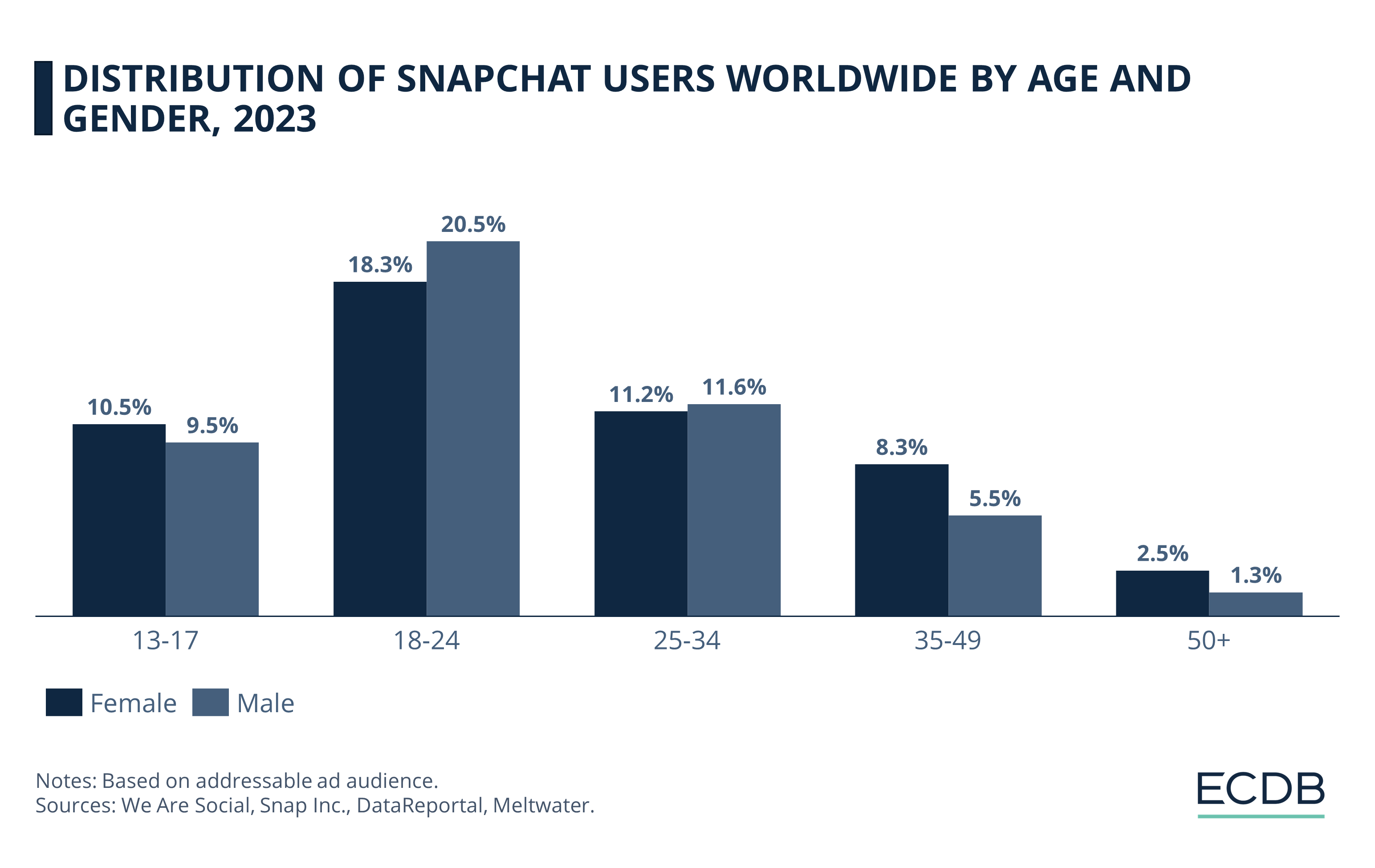
Snapchat's approach to social commerce revolves around trends that brands need to be aware of to effectively reach today's consumers. The platform has become a leading mode for product discovery, especially among Gen Z and Millennials, who prefer using social media over traditional online marketplaces or search engines. Snapchat emphasizes the importance of integrating friends and family into the shopping journey, leveraging direct messages, tags, and live shopping events to influence purchasing decisions. This approach highlights the value of personal recommendations over influencer endorsements.
One significant trend is the rise of Augmented Reality (AR) in shopping experiences. Snapchat reports that two-thirds of consumers would be less inclined to shop in-store if they could virtually try products beforehand. This technology, especially prevalent among regular Snapchat users, instills confidence in purchase decisions, potentially leading to increased brand profitability through reduced returns.
To cater to these evolving consumer behaviors, Snapchat advises brands to invest in social shopping features like Discover tabs, Shopping tabs, Shoppable Buttons, and AR. These tools simplify product discovery and purchase processes, making social commerce more appealing and accessible to users.

Top Social Commerce Platforms: Closing Thoughts
Social commerce isn't just a buzzword—it's a game-changer for both customers and businesses. The insights gathered from platforms like Facebook, Instagram, YouTube, TikTok, Pinterest, and Snapchat reveal a dynamic shift towards integrated shopping experiences.
With vast user bases, these platforms offer unforeseen opportunities for brands to engage directly with potential buyers, driving sales in a more personalized and interactive manner. For customers, the convenience of discovering and purchasing products within the familiar context of their favorite social media apps enhances the shopping journey, making it seamless and enjoyable.
By leveraging the unique features and strengths of each platform—be it Facebook's massive reach, Instagram's visual appeal, YouTube's in-depth reviews, TikTok's engaging content format, Pinterest's inspiration-driven discovery, or Snapchat's AR experiences—brands can craft targeted strategies that resonate with their audience. Embracing social commerce is not just about keeping up with trends; it's about harnessing the power of social media to connect, convince, and convert in a digital age where commerce is increasingly interactive.
Sources: ECDB, Facebook, Google, Hootsuite, HubSpot, Instagram, Klarna, Kolsquare, MarketBeat, Meta, Pinterest, PYMNTS, SimplicityDX, Snapchat: 1, 2, Statista, Social Native, TikTok, Vista Social

Click here for
more relevant insights from
our partner Mastercard.
Related insights
Deep Dive
TikTok Shop Expands Operation in the United States
TikTok Shop Expands Operation in the United States
Deep Dive
YouTube Partners With Flipkart and Myntra to Launch YouTube Shopping in India
YouTube Partners With Flipkart and Myntra to Launch YouTube Shopping in India
Deep Dive
Gen Z Online Shopping Behavior: Consumer Habits, Preferences & Trends
Gen Z Online Shopping Behavior: Consumer Habits, Preferences & Trends
Deep Dive
Live Commerce in Italy: Consumer Behavior & Preferences
Live Commerce in Italy: Consumer Behavior & Preferences
Deep Dive
Trends in German eCommerce: Germans Like What They Know
Trends in German eCommerce: Germans Like What They Know
Back to main topics